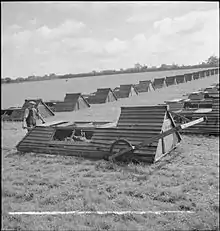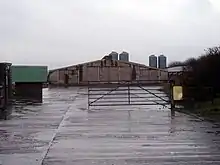Chicken manure
Chicken manure is the feces of chickens used as an organic fertilizer, especially for soil low in nitrogen.[1] Of all animal manures, it has the highest amount of nitrogen, phosphorus, and potassium.[2] Chicken manure is sometimes pelletized for use as a fertilizer, and this product may have additional phosphorus, potassium or nitrogen added.[3] Optimal storage conditions for chicken manure include keeping it in a covered area and retaining its liquid, because a significant amount of nitrogen exists in the urine.[4]
(NRCS_Photo_Gallery).jpg.webp)



Fresh chicken manure contains 0.5%[5] to 0.9% nitrogen,[6] 0.4%[4] to 0.5% phosphorus,[5] and 1.2% to 1.7 %potassium.[5] One chicken produces approximately 8–11 pounds of manure monthly.[6] Chicken manure can be used to create homemade plant fertilizer.[6]
Studies
In 1986, a master's thesis study in the Philippines compared the effects of using various fertilizers to enhance milkfish production in brackish water ponds.[7] The study compared the use of using chicken manure only, cow manure only, 16-20-0 fertilizer only, a mixture of cow manure and 16-20-0 fertilizer, a mixture of chicken manure and 16-20-0 fertilizer, and a control group that used no fertilizer.[7] The study concluded that the use of cow manure only as a fertilizer fared best, and the use of chicken manure only as a fertilizer fared second best.[7]
Pollution
Mass applications of chicken manure may create an unpleasant odor. In April 2014 in Escondido, California, a golf course that had "dumped" chicken manure on its grounds was cited by the county government after complaints from local residents about the odor.[8]
In December 2011, the environmental group Environment Maryland asserted that water runoff from agricultural land fertilized with chicken manure was increasing the pollution levels of Chesapeake Bay.[9] The group asserted that excessive phosphorus from the runoff was contributing to the increase of dead zones in the bay.[9] In 2015, in efforts to address the matter before leaving office, Maryland Governor Martin O'Malley put a new regulation into use that "would have limited the amount of poultry manure that Eastern Shore farmers can use on their fields".[10] However, the following Governor Larry Hogan quickly absolved the new regulation after being sworn into office.[10] The runoff problem has been attributed to the use of "an outdated scientific tool for calculating the correct amount of manure".[10] A proposed solution from scientists at the University of Maryland is to have farmers use a new (corrected) formula to calculate proper quantities of chicken manure for agricultural uses.[10]
Human deterrent
Chicken manure has been used as a human deterrent. In July 2013, in Abbotsford, British Columbia, city workers applied chicken manure at a tent encampment to deter homeless people from the area.[11] The affected homeless planned on initiating small claims lawsuits for loss of property and property damage.[11] One of the affected homeless people described the tactics of city workers as "a chicken shit way to do things".[12] The mayor of Abbotsford and the Fraser Valley city manager later apologized regarding the incident.[11][13] Similar instances of using chicken manure in this manner have occurred in British Columbia in Surrey and in Port Coquitlam, the latter of which occurred "shortly after the Abbotsford incident".[11]
See also
- Chicken shit
- Guano
- Liquid manure
- Manure spreader
- Plant nutrition
 Agriculture and Agronomy portal
Agriculture and Agronomy portal- Labeling of fertilizer
References
- Telkamp, Mick. "The Straight Poop On Using Chicken Manure as Fertilizer". Retrieved 16 February 2015.
- Deborah L. Martin; Grace Gershuny, eds. (1992). The Rodale Book of Composting: Easy Methods for Every Gardener (revised ed.). Rodale. p. 126. ISBN 9780878579914.
- Barrett, J. (2008). FCS Soil Science L3. FET college series. Pearson Education South Africa. p. 70. ISBN 978-1-77025-114-4.
- Pullin, R.S.V.; Shehadeh, Z.H. (1980). Integrated Agriculture-aquaculture Farming Systems: Proceedings of the ICLARM-SEARCA Conference on Integrated Agriculture-Aquaculture Farming Systems, Manila, Philippines, 6-9 August 1979. ICLARM conference proceedings. International Center for Living Aquatic Resources Management. p. 80.
- "Manure is an Excellent Fertilizer". Ecochem. Ecochem. Retrieved December 11, 2016.
- Foreman, Patricia; Long, Cheryl (April–May 2013). "Chickens in the Garden: Eggs, Meat, Chicken Manure Fertilizer and More". Mother Earth News. Retrieved February 18, 2015.
- Garcia, Y.T.; Aragon, C.T.; Dator, M.A.L. Milkfish Bibliography A Compilation of Abstracts on Milkfish Studies. WorldFish. p. 191.
- "Chicken manure stink could be costly". U-T San Diego. April 14, 2014. Retrieved February 18, 2015.
- "Chicken manure adds to Chesapeake Bay pollution, group says". WTOP. December 28, 2011. Retrieved February 18, 2015.
- "Hogan shelves chicken manure rules". The Frederick News-Post. January 27, 2015. Retrieved February 18, 2015.
- "Big Stink Over Manure Dump". The Huffington Post. July 24, 2013. Retrieved February 18, 2015.
- "Abbotsford Homeless Campers Clash With City, Police". The Huffington Post. June 19, 2013. Retrieved February 18, 2015.CS1 maint: ref=harv (link)
- "Chicken Poop Scheme Shames Mayor". The Huffington Post. June 6, 2013. Retrieved February 18, 2015.CS1 maint: ref=harv (link)
Further reading
- Raston, Kate (January 8, 2015). "A new use for chicken manure". The West Australian. Retrieved February 18, 2015.
- Patience, Martin (June 25, 2012). "Poultry power: Turning chicken manure to energy". BBC News. Retrieved February 18, 2015.
- "Are humans endangered if cattle dine on chicken manure?". CNN. August 23, 1997. Retrieved February 18, 2015.
- Dabney, Seth Mason (May 1978). Chicken manure in New York State. Cornell University.CS1 maint: ref=harv (link)